The development of sterile drug formulations has various challenges, often related to aseptic processing and selection of the suitable excipient. A cellulosic polymer currently under investigation for use as an excipient in sterile drug formulations is hydroxypropyl cellulose or HPC.
Additive-free HPC has already been shown to have some useful properties as an excipient in sterile preparations such as ophthalmic and subcutaneous injectables.
For formulations using HPC, however, terminal sterilisation methods of autoclaving and gamma irradiation can break the cellulosic polymer chains of the HPC affecting the viscosity and any associated critical-to-quality attributes that the excipient may otherwise provide.
A method of sterilisation that can be employed to avoid such an outcome is filtration through a sterilising grade membrane filter.
Because of the effect HPC has on the viscosity of a fluid, HPC solutions can be challenging to pass through sterilising grade filtration media that has been designed to remove sub-micron contaminant species. This can impact upon the end user's specification of effectively sized and easy to use sterilising grade filter system.
Selection of an optimal combination of HPC type and filtration system, therefore, is crucial for successful processing of products with HPC as an excipient.
Materials and methods
Working in collaboration with Nippon Soda, Pall Corporation investigated the factors relevant for successful sterile filtration of HPC.

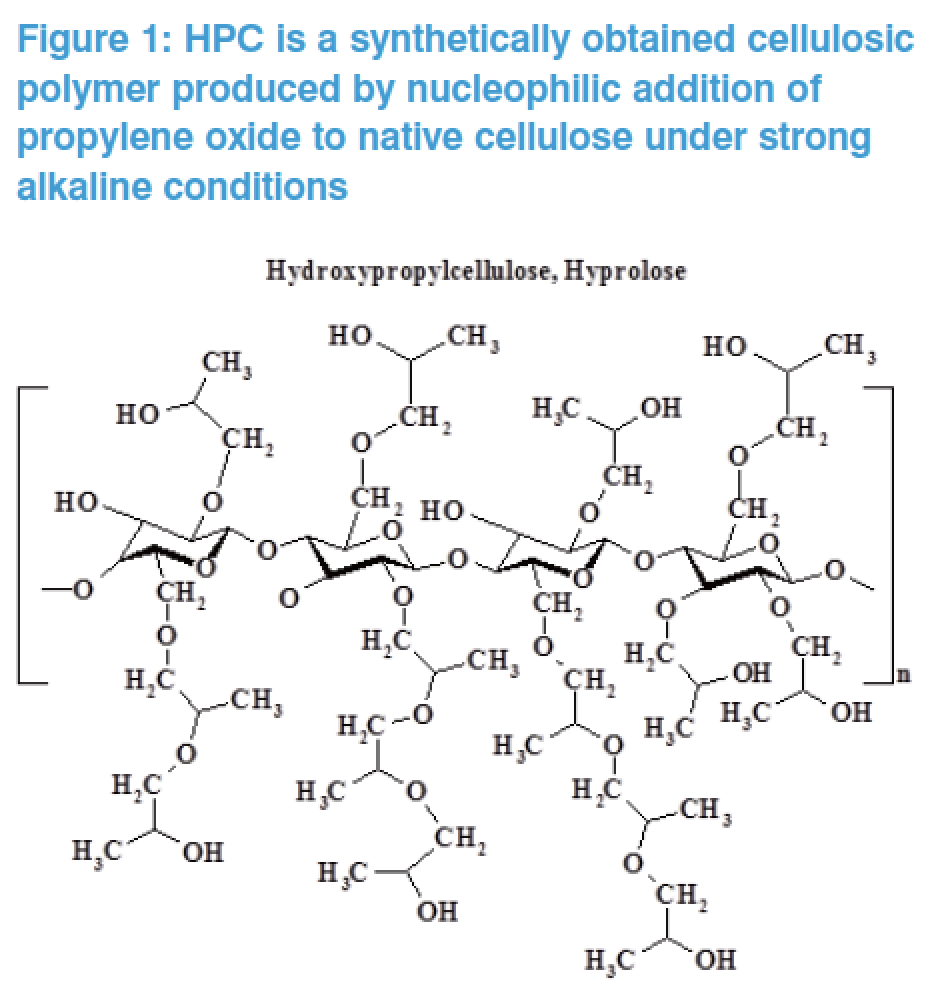
Tests were made in solution trials with different grades of HPC at different concentrations with a range of sterilising grade filters.
Filtration trials were performed with 47mm discs of the described membrane contained in a stainless-steel filter disc holder. During each filter evaluation, constant air pressure was applied to the HPCs solution at 1bar to pass it through the filtration device. The filtrate was collected in a vessel on a balance and the change in weight over time was recorded.
The experiments were performed at 20-22°C. The HPC grade with the lowest molecular weight (HPC SSL) was first used to assess filtration behaviour with different types of sterilising grade membranes.
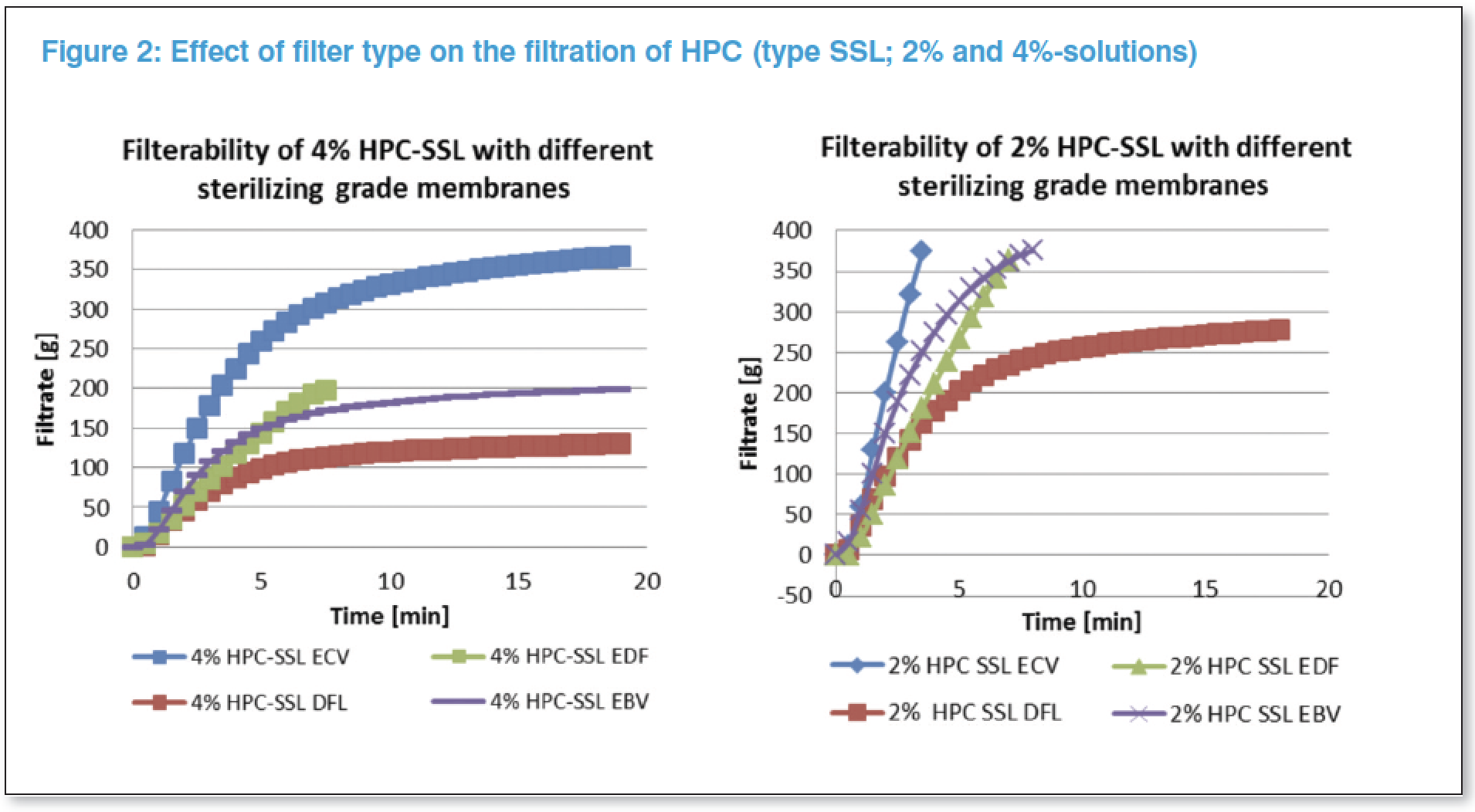
Figure 2 shows that the highest throughputs for 2% and 4% solutions of HPC SSL are achieved with sterilising grade filters using filter media made of polyethersulfone (PES) and incorporating an asymmetric filter layer upstream of a symmetric layer. The initial filtration rate was faster for filters using exclusively PES membrane compared with filters containing layers of polyvinylidene fluoride (PVDF).
The negative effect is not only a decrease in filtration speed due to the higher viscosity of the solution but also a reduction in total throughput. This is indicative of the presence of components tending towards a particular nature that leads to membrane fouling.
Regardless of the HPC concentration, the ranking of the sterilising grade membranes testing with respect to total throughput and filtration speed stayed the same.
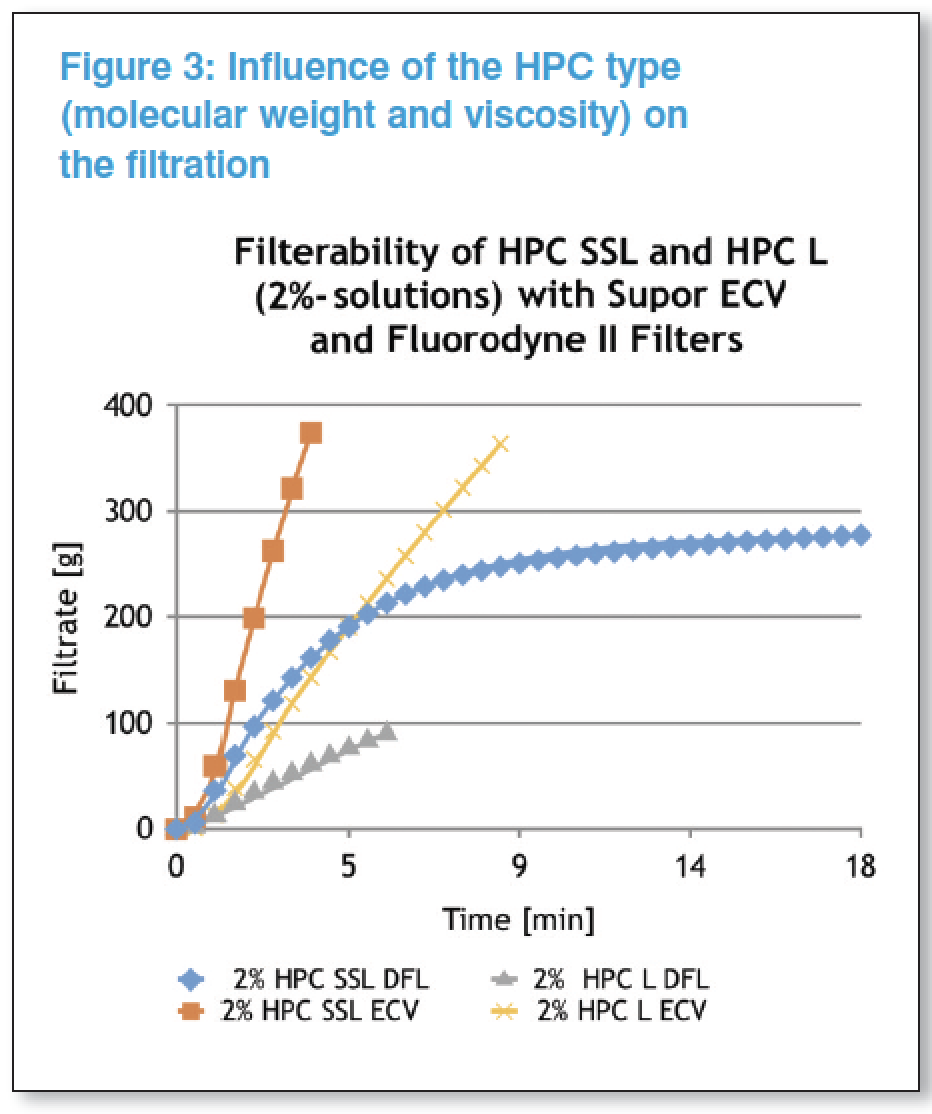
Influence of the HPC type
Two different types of HPC (HPC SSL and HPC L) were used to investigate the influence of viscosity of the solution in combination with the molecular weight of the HPC type.
Filtration behaviour was monitored using the filter types that gave the highest total throughput in the previous trial with HPC SSL at different concentrations and the one that gave the lowest throughput.
Figure 3 illustrates that the higher viscosity/higher molecular weight HPC showed a lower filtration flow rate compared with HPC with lower viscosity/lower molecular weight for both filter types under test.
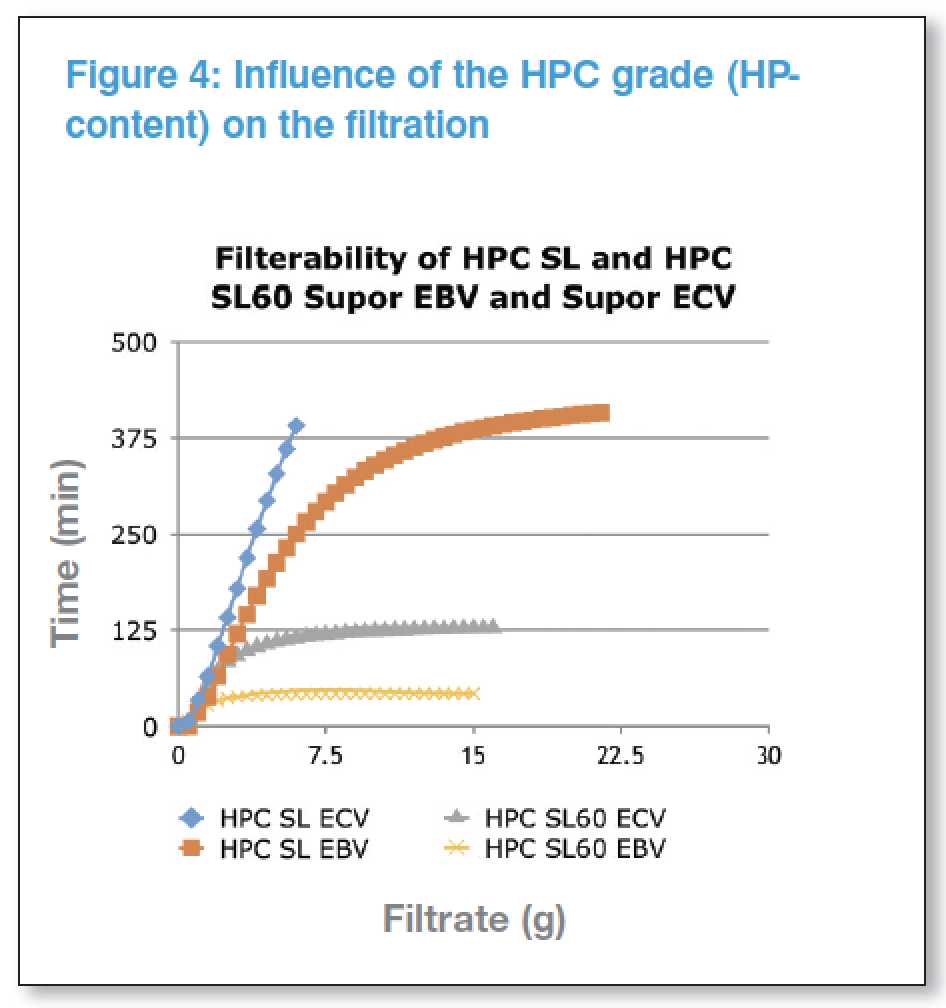
To test for the influence of the HP content on filtration, two HPC grades with the same molecular weight but different HP content (HPC SL60 [60% HPO] and HPC-SL [65% HPO]) were tested.
These were prepared in solution at equal concentration and viscosity prior to filtration through two sterilising grade filters using PES filtration media.
One of the filters chosen incorporated an asymmetric prefiltration membrane layer upstream and the other, a symmetric filtration layer upstream. Results are illustrated in Figure 4.
Filtration flow and total throughput were found to be significantly lower for the HPC with lower HP content (HPC SL60) regardless of the upstream membrane layer used in the sterilizing grade filters tested.
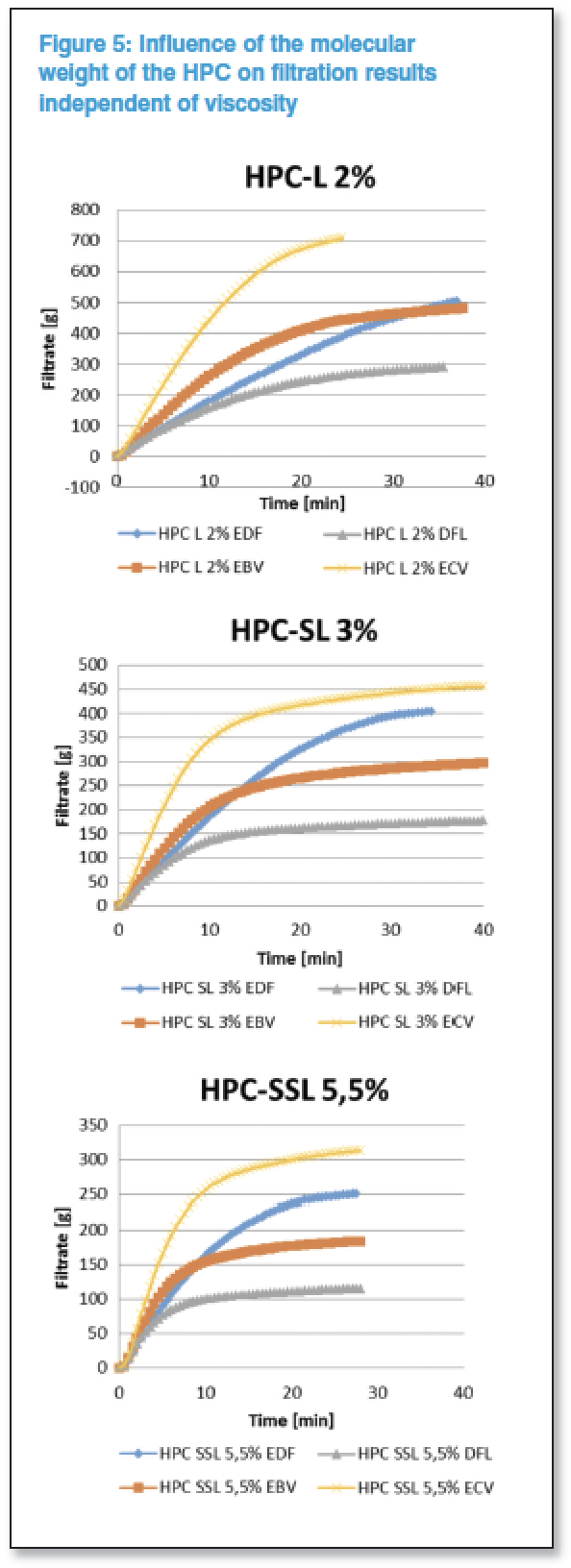
To eliminate the effect of viscosity on the filtration results, trials were carried out with different molecular weight HPC grades at concentrations giving the Figure 3: Influence of the HPC type (molecular weight and viscosity) on the filtration Figure 5: Influence of the molecular weight of the HPC on filtration results independent of viscosity same viscosity (8mPas) for all solutions under test.
Influence of the HPC molecular weight
Filtration results of different HPC grades at the same viscosity were found to be strongly influenced by the molecular weight of the HPC. Figure 5 illustrates the performance of the different filter types with HPC of different molecular weight at the same viscosity.
Total throughput for all filter types decreased significantly with decreasing molecular weight of the HPC.
The ranking of filtration performance of the different filter types, in terms of flow and throughput, remains consistent for all three types of HPC tested for this trial.
Figure 6 illustrates the influence of molecular weight on throughput for the best performing filter type.
Influence of prefiltration
The filtration performance of a sterilising grade filter can often be improved by using a prefiltration step.
During these studies, filtration trials were performed using a pre-filter placed upstream of sterilising grade filter. The HPC type found to be most challenging to filter with a standalone sterilising grade filter (HPC SL60) was used.
As shown in Figure 7, the placement of a prefilter upstream of a sterilising grade filter significantly enhanced throughput of the final filter. This was observed for both the sterilising grade filter with an asymmetric membrane layer and the filter type with a symmetric membrane pairing.
Conclusions and recommendations
The filtration performance of a sterilising grade filter can often be improved by using a prefiltration step. During these studies, filtration trials were performed using a pre-filter placed upstream of sterilising grade filter. The HPC type found to be most challenging to filter with a standalone sterilising grade filter (HPC SL60) was used.
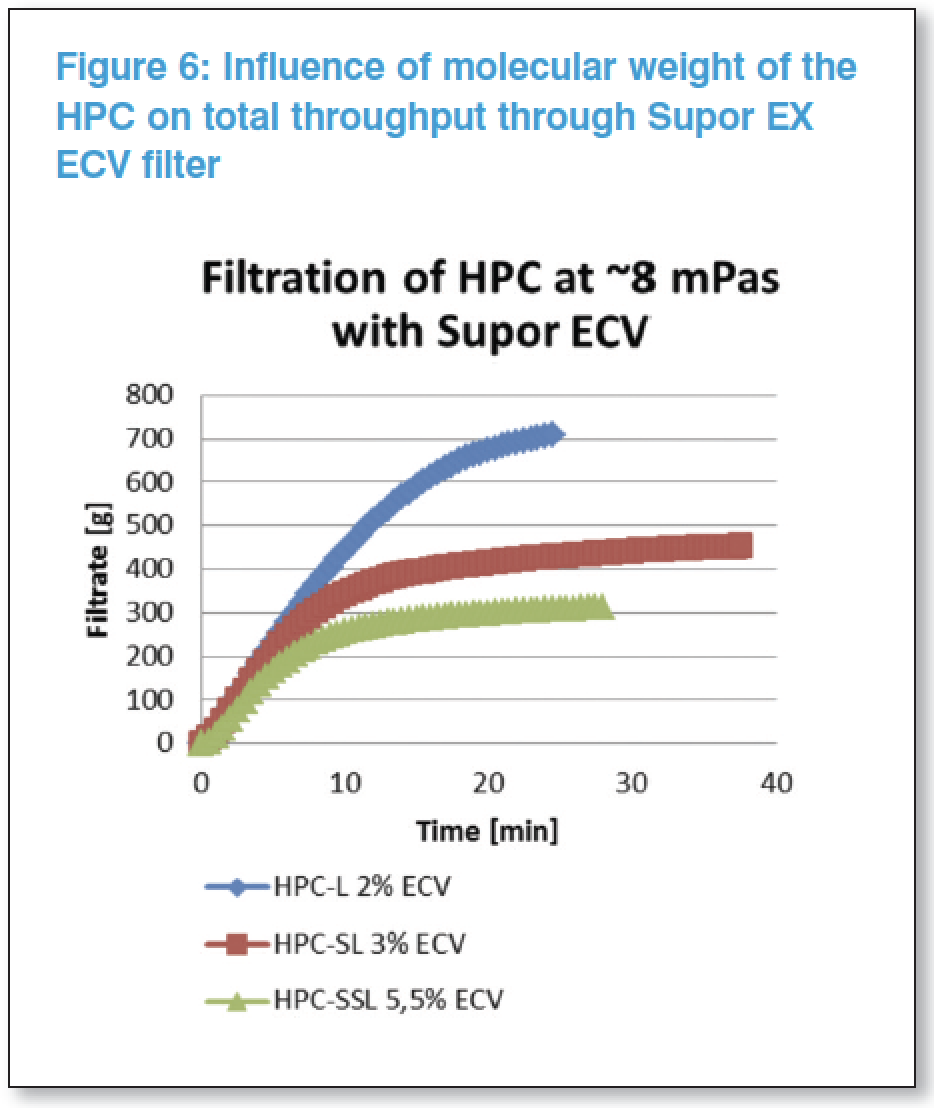
As shown in Figure 7, the placement of a prefilter upstream of a sterilising grade filter significantly enhanced throughput of the final filter. This was observed for both the sterilising grade filter with an asymmetric membrane layer and the filter type with a symmetric membrane pairing. Conclusions and recommendations The tests performed show the flow rate and throughput behaviour of several types of sterilising grade filter with and without prefiltration, when used to filter different types of HPC solution under constant pressure.
When tested over a range of conditions, sterilising grade filters incorporating an asymmetric upstream layer achieved a higher total throughput compared with sterilising grade filters using a symmetric upstream membrane layer.
Initial flow rates were always higher for sterilising grade filters made completely of PES membrane.
For all types of filter, higher throughputs corresponded with the use of HPC grades of higher molecular weight at constant viscosity, whereas lower throughputs corresponded with the use of HPC grades of increasing concentration at a constant molecular weight.
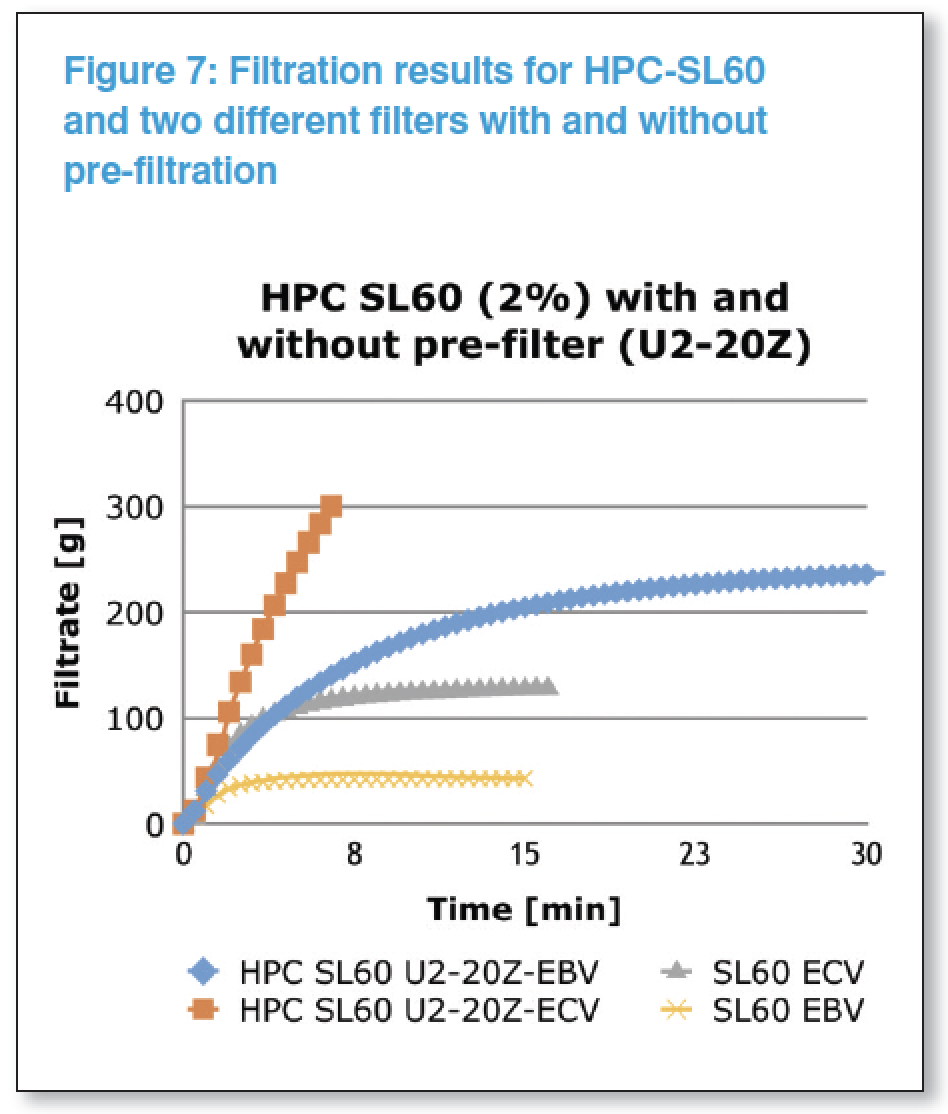
Filtration studies with HPC solutions passed through a glass fibre prefilter upstream of a sterilising grade filter show that the implementation of a prefilter can be used to extend the service life or help with the sizing of a smaller final filter than would be achievable with a sterilising grade filter alone.
These findings provide some evidence about the process conditions that can allow for the drug manufacturer or developer to size effective to operate filter systems with
high capacity for HPC solutions.Due to lower membrane area to fluid volume processed, high capacity filters not only help with the management of filtration costs, but they may also impart qualitative benefits such as improved product yield and low leachable. To achieve this, a sterilising grade filter such as Supor EX ECVwould be recommended to deliver superior throughput with viscous HPC containing feeds, regardless of molecular weight and viscosity.


Filter selection Should further improvements around filter capacity be sought, then the performance of a sterilising grade filter with an asymmetric membrane can be enhanced using an HPC grade with molecular weight, management of solution viscosity, and/or the implementation of prefiltration.
It is recognised that the critical-toquality attributes of a drug formulation may be dependent on a specific excipient concentration and this should always be considered prior to performing any optimisation work based on the above recommendations.
Also, filter selections based on flow rate and throughput should be evaluated in combination with a risk assessment that considers other critical-to-quality parameters to the end user.
These might be the ability of the filter to produce a sterile effluent under “worst case” process conditions; the relationship between the filter membrane and adsorption of active ingredients in addition to the excipient; or the compatibility of the filter over the full duration of exposure to the filtered fluid.
The making of HPC
HPC is a synthetically obtained cellulosic polymer produced by nucleophilic addition of propylene oxide to native cellulose under strong alkaline conditions. The cellulose hydroxyl groups (HPO) are substituted by hydroxypropoxy groups (Figure 1). The resulting chemical moiety is more unipolar and hydrophobic compared with native cellulose. The low level of intermolecule hydrogen bonds in the HPC molecule confers water solubility. The bivalency of the HPC molecule, due to the presence of a hydrophilic core (cellulose chain) and hydrophobic side chains (polypropylenoxyde) provides some unique properties, for example, the ability to stabilise nano suspension solutions of poorly soluble molecules.
N.B. This article is featured in the December 2018 issue of Cleanroom Technology. The digital edition is available online.




